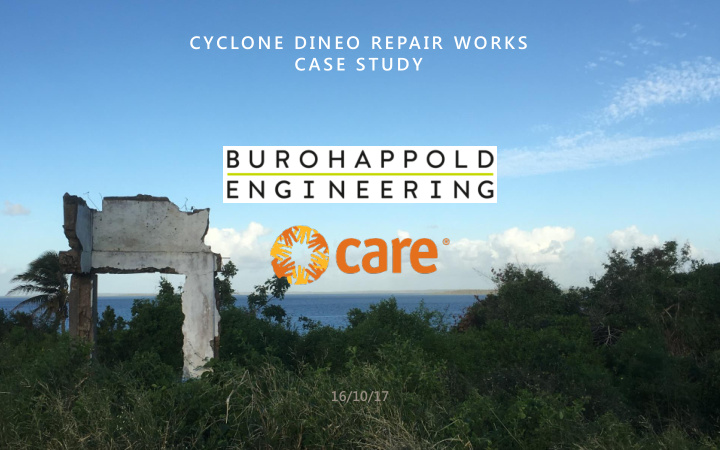



C YC LON E D IN E O RE PA IR W ORK S C A S E S T UD Y 16/10/17
C YC LO NE DINEO Cyclone Dineo hit Mozambique on the 15 th of February 2017 Around 20,000 homes were destroyed and approximately 130,000 people affected. Responding to disasters like this makes up the great majority of CARE’s impact & reach.
RESP O NSE After an initial response with food, emergency shelter and other basic relief items, focus moved to repairs to schools and health centres. CARE International UK deployed a shelter specialist to Mozambique to support – later followed up by a further visit. We couldn’t find a suitable Portuguese speaking engineer at short notice – so undertook a rapid tender process for engineering support in the UK.
AIMS & REQ U IREMENTS The intention was to get procurement and construction underway within the timescale set by some very short-term emergency funding, without compromising on the design standards. To do this we needed: The ability to visit the project locations The ability to work flexibly within the ever-changing context of an emergency response Ability to provide adequate minimum service within an extremely limited budget – max £10,000 Ability to produce documentation in Portuguese
RESU LTS & LESSO NS Buro Happold were able to be very responsive and flexible by utilising a large team Work was only done when CARE gave confirmation to proceed, as the list of buildings to be repaired kept changing. CIUK played a minor role ensuring good understanding between CARE Mozambique & Buro Happold – but most communication was direct. Changes and gaps in CARE’s staffing meant much potential and actual confusion. CIUK was only able to mitigate this somewhat. Donors changed the goalposts somewhat, expanding the scope of work and timelines. Assumptions that local contractors could interpret typical details provided proved wrong, and UN Habitat undertook a secondary detailed design stage. The approach achieved its main objective of delivering a rigorous structural design and getting procurement & construction underway.
FEEDBAC K FRO M C ARE MOZAMBIQ U E “I would say, mostly, it was the prompt response and deployment that was critical to show to the Donor and Local Communities our professional structure and response capacity . ” “The quality of the design works, despite not enough for this specific local UN-HABITAT standards, was also positive in the sense of an international concept of structural design was delivered and combined with others for the introduction and understanding of the local government and communities . ” “Important to recall that, as part of an unconventional pilot project, still not yet fully developed and experimented by the UN until CARE´s setting of the example, BH and ourselves were the first to implement and deal with a large scale resilient roof rehabilitation and at same time get the real costs and deal with the necessary adjustments and corrections on drawings, specifications and quantities”
SCO P E AND DAMAG E
REPAIR STRATEGIES
IMP LEMENTATIO N AND TIMELINE IDC
P R O G R E S S
C ARE/ BU RO HAP P O LD CO LL ABO RAT IO N Collaboration enabled quick response and cost saving CARE tendered within 5 months of the disaster Facilitated by existing CARE infrastructure Enabled CARE to shift response
HO W C AN THE P RIVATE SEC TO R HELP, AND WHAT IS NEEDED TO U NLO C K TH E P OTE NTIAL? What we can bring: BuroHappold “Share Our Skills” Scheme – average 200 person days per year Passionate people who want to make a difference Breadth and depth of expertise Understanding of how projects are built What do we need: Local knowledge/framework/infrastructure A partner/client who can appreciate/understand how we can work….and get the best from us
ANY QUESTIONS?
Recommend
More recommend